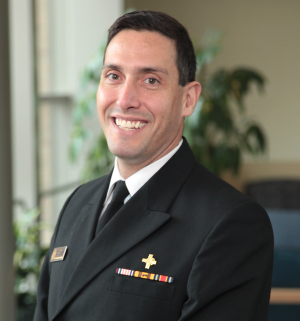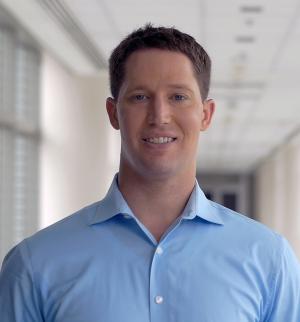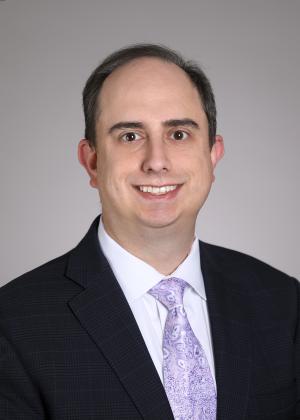Colleagues: Recently Tenured
DANIEL S. CHERTOW, M.D., CC, NIAID
Senior Investigator and Head, Emerging Pathogens Section, Critical Care Medicine Department, NIH CC and NIAID Laboratory of Virology

Education: Boston College, Newton, Massachusetts, (B.A. in sociology); University of California at Berkeley (M.P.H.); Northwestern University Feinberg School of Medicine, Chicago (M.D.)
Training: Internal medicine internship and residency, University of California at San Diego (2000–2003); epidemic intelligence service officer, United States Centers for Disease Control and Prevention (CDC), Atlanta (2004-2006); critical care medicine fellow, NIH Clinical Center (2007–2008); infectious diseases fellow, Johns Hopkins University, Baltimore (2008–2010)
Before coming to NIH: Epidemic intelligence service officer, CDC
Came to NIH: In 2007 as a critical care medicine fellow, NIH Clinical Center
Outside interests: Swimming; surfing
Website: https://irp.nih.gov/pi/daniel-chertow
Research interests: My research group focuses on gleaning mechanistic insights into the pathogenesis of critical illness due to severe emerging or re-emerging infectious diseases including Ebola virus disease and COVID-19. To accomplish our research aims we use human natural history studies during life and postmortem, in vitro mechanistic studies, and advanced animal models. In a recent autopsy study of 44 fatal COVID-19 cases, we determined that severe acute respiratory syndrome coronavirus (SARS-CoV-2) infects cells and tissues throughout the body, including the brain, and that SARS-CoV-2 RNA and protein may persist in tissues for months (Nature 612:758–763, 2022).
BRIAN GLANCY, PH.D., NHLBI
Senior Investigator, Muscle Energetics Laboratory, NHLBI; secondary appointment at NIAMS

Education: University of the Pacific, Stockton, California (B.A. in sports science); Arizona State University, Tempe, Arizona (M.S. in kinesiology, Ph.D. in exercise science)
Training: Postdoctoral fellow, NHLBI (2009–2016)
Before coming to NIH: Graduate student at Arizona State University
Came to NIH: In 2009 as a postdoctoral fellow, NHLBI
Outside interests: Playing football; sports; good food
Website: https://irp.nih.gov/pi/brian-glancy
Research interests: Skeletal muscle is the most abundant tissue in humans and faces near-instantaneous changes in demand for force production lasting from seconds to minutes to hours. Initiating and maintaining muscle contraction requires rapid, coordinated movement of signals and material within and among various structures located throughout the relatively large muscle cell. The Muscle Energetics Laboratory focuses on the energy-distribution aspect of continued muscle contraction, deficits in which have been implicated in many pathologies including diabetes and muscular dystrophy as well as aging. In particular, we aim to determine how mitochondria are optimized as part of the integrated muscle cell to maintain energy homeostasis during the large change in energy demand caused by the onset of muscle contraction. We recently identified several genes that determine where mitochondria are placed within fly skeletal muscles (Nat Commun 13:661, 2022) as well as how the location of mitochondria determines the structure of the adjacent contractile machinery within striated muscle cells of flies, mice, and humans (Nat Commun 13:6058, 2022).
MARIO PENZO, PH.D., NIMH
Section Chief, Neural Circuits of Emotion and Motivation, NIMH

Education: University of Puerto Rico at San Juan (B.S. in biology); Albert Einstein College of Medicine, New York (Ph.D. in neuroscience)
Training: Postdoctoral fellow, Cold Spring Harbor Laboratory, Laurel Hollow, New York (2011-2015)
Came to NIH: In 2015 as an investigator, NIMH
Outside interests: Church; sports; music; wine
Website: https://irp.nih.gov/pi/mario-penzo
Research interests: Our mission is to identify the molecular, cellular, and neural circuit mechanisms underlying emotional and motivated behaviors. To fulfill this mission, our laboratory implements a multidisciplinary approach that includes behavioral assays as well as cutting-edge technologies for monitoring and manipulating the activity of defined neuronal populations in mice. Current research efforts are centered on investigating the contributions of the dorsal midline thalamus to aversive and reward-seeking behaviors (Nat Neurosci 24:1429–1440, 2021). For this, we use in vivo calcium-imaging techniques in conjunction with optogenetic and chemogenetic approaches while animals perform appetitive and defensive behavioral tasks. In addition, our laboratory uses patch-clamp electrophysiology in acute brain slices, along with pharmacological and genetic tools to investigate the cellular and molecular mechanisms that underlie behavior (Nat Neurosci 23:217–228, 2020).
ADAM G. SOWALSKY, PH.D., NCI
Senior Investigator and head of the Prostate Cancer Genetics Section, Genitourinary Malignancies Branch, NCI Center for Cancer Research

Education: The University of Texas at Austin (B.S. in cell and molecular biology); Tufts University Graduate School of Biomedical Sciences, Boston (Ph.D. in biochemistry)
Training: Postdoctoral training in molecular pathology and bioinformatics, Harvard Medical School and Beth Israel Deaconess Medical Center, Boston (2010–2014)
Before coming to NIH: Instructor in medicine at Harvard Medical School
Came to NIH: In 2015 as an investigator in the Laboratory of Genitourinary Cancer Pathogenesis, NCI
Outside interests: Teaching my young children to cook; swimming; attending Major League Baseball games
Website: https://irp.nih.gov/pi/adam-sowalsky
Research interests: I lead a translational research program focused on understanding the contributions of prostate cancer evolution toward therapy resistance and treatment response. Using patient samples from NCI clinical trials, we combine bench-based methods with cutting-edge computational approaches to assess tumor-based biomarkers and mechanism of progression in patients with locally advanced prostate cancer, with a goal [of identifying] novel targets that can be tested therapeutically (Cancer Res 78:4716–4730, 2018). Intratumoral heterogeneity in prostate cancer is a well-acknowledged property of the disease, but our group was the first to demonstrate therapeutic consequences for this heterogeneity in individual patients (Nat Commun 11:article number 837, 2020; JCO Precis Oncol 5:1514–1522, 2021).
We have further identified prostate cancer biomarkers for identifying residual disease after intense hormonal therapy (J Urol 208:90–99, 2022) and observed direct correlations between the ability of tumors to resist therapy and their evolutionary trajectories (Eur Urol 80:746–757, 2021). In the longer term, we are working with physician colleagues to translate the targets and biomarkers we have identified into new clinical trials.
MICHAEL WARD, M.D., PH.D., NINDS
Senior Investigator, Neurogenetics Branch, NINDS

Education: Kenyon College, Gambier, Ohio (B.S. in biology); Washington University in St. Louis, St. Louis (M.D., Ph.D., in molecular biology)
Training: Neurology resident, University of California at San Francisco (2008–2011); postdoctoral fellow, Gladstone Institutes, San Francisco (2011–2013)
Before coming to NIH: Instructor, University of California at San Francisco
Came to NIH: In 2015 as an assistant clinical investigator, NINDS
Outside interests: Snowboarding; hiking; playing guitar
Website: https://irp.nih.gov/pi/michael-e-ward
Research interests: Our research focuses on cellular and molecular mechanisms of frontotemporal dementia (FTD) and amyotrophic lateral sclerosis (ALS), two related neurodegenerative disorders. We use a combination of cell biology and proteomic and functional genomic approaches in induced pluripotent stem cells (iPSC) neuron models of ALS and FTD, with a long-term goal of understanding how disease-associated familial mutations lead to neurodegeneration.
Our group has made several major contributions to the field over the past several years: 1) Discovery of a new mechanism of axonal RNA transport in neurons that involves lysosomal hitchhiking, a process that goes awry in familial ALS (Cell 179:147–164, 2019); 2) characterization of dysregulated splicing in ALS and FTD due to mislocalization of TDP-43, uncovering novel disease-relevant splicing targets and potential biomarkers (Nature 603:131–137, 2022); 3) discovery of widespread DNA break and repair events at neuronal enhancers that are likely necessary for epigenetic regulation (Nature 593:440–444, 2021); 4) new tools that enable large-scale production of human iPSC-derived neurons and genome-wide CRISPR/Cas9 gene-editing method interference screens, as well as co-conception and management of a large-scale genome-engineering iPSC initiative with NIA’s Mark Cookson (Neuron 109:1080–1083, 2021).
This page was last updated on Saturday, November 23, 2024
